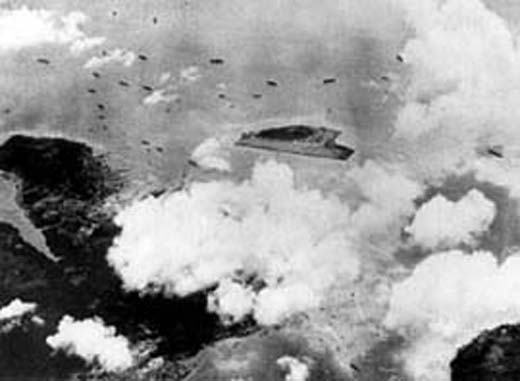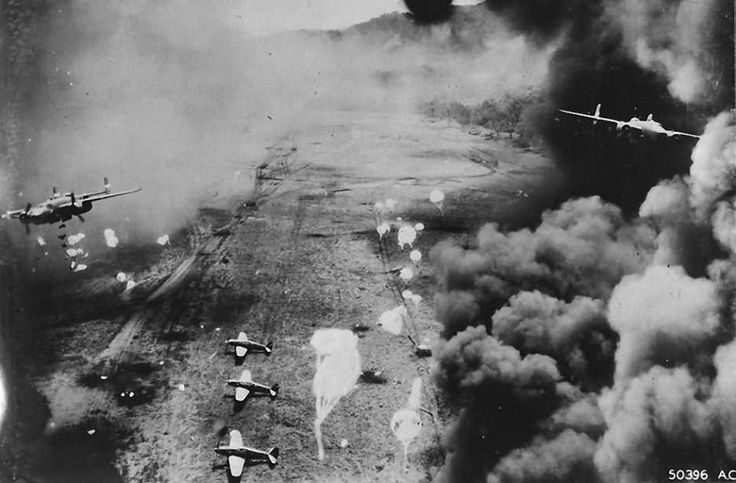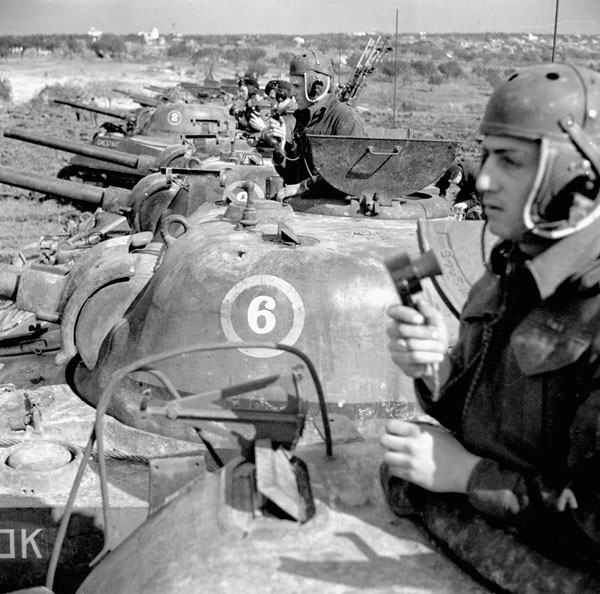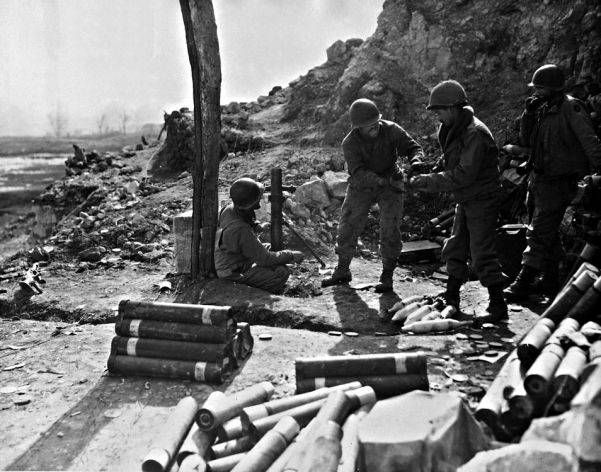Air Operations, Bismarcks
- 25 42nd Medium Bomb Group B-25s, escorted by more than 40 AirSols fighters, attack Rabaul's Tobera airfield. 18 XIII Bomber Command B-24s, escorted by more than 30 AirSols fighters, attack the Vunakanau airfield at Rabaul.
- A 347th Fighter Group P-38 downs 1 A6M Zero over Rabaul's Vunakanau airfield at 1130 hours. 1 VF-17 F4U downs another Zero over the Tobera airfield, Rabaul at 1130 hours. VMF-212 F4Us down 1 Zero over the Rabaul area at 1205 hours.
Air Operations, CBI
BURMA- 12 10th Air Force P-51s attack the airfield at Indaw.
Air Operations, Carolines
2 VMD-254 PB4Ys depart Stirling Airfield in the Treasury Islands during the night of February 3-4 to mount a dawn photographic-reconnaissance mission to the Truk Atoll. Fire from a Japanese battleship and a chase by several A6M2-N 'Rufe' fighters fail to stop the mission. At the conclusion of the 12-hour flight, both PB4Ys land safely at the Piva Uncle airfield on Bougainville. As a result of the mission, however, the Japanese Navyís Combined Fleet will depart from the Truk anchorage on February 10, never to return. Nevertheless, while many large warships leave, smaller ones and many merchant ships remain.
[Air Operations, East Indies
V Bomber Command B-24s and B-25s attack Laha (Ceram), Amboina Island, and Namlea (Boeroe).
[Air Operations, Europe
RAF BOMBER COMMANDEvening Ops:
- 9 Mosquitos are sent to Frankfurt, 5 to Elberfeld and 1 to Aachen, there are 2 Serrate patrols, 28 aircraft lay mines in the Bay of Biscay, and 49 aircraft are involved in Resistance operations. Included in that total are 27 Stirlings, 17 Halifaxes, 3 Lysanders and 2 Hudsons. This is the first widespread use of the No. 3 Group Stirling squadrons for Resistance operations work.
- There are no losses.
GERMANY:
- 346 1st and 3rd Bomb Division B-17s and 27 2nd Bomb Division B-24s attack marshalling yards at Frankfurt am Main, and 197 B-17s and 63 B-24s attack numerous targets of opportunity throughout northwestern Germany.
- 2 B-24s and 18 B-17s are lost, 3 damaged bombers are written off; 203 crewmen are missing
- Escort and support for the bombers is provided by 56 P-38s, 537 P-47s, and 44 P-51s. P-47 pilots down 8 Luftwaffe aircraft along the bomber track over Belgium between 1300 and 1330 hours.
- 1 P-38 and its pilot are lost
ITALY:
- Most of the 12th Air Force is grounded due to bad weather, bu P-40s and Spitfires are able to patrol the Anzio beachhead area, where a powerful German Army ground offensive is launched.
FRANCE:
- 15th Air Force B-17s attack the Vichy Naval base at Toulon, but all the B-24s dispatched on the same mission abort in the face of bad weather. A number of B-17s that become separated from the main force attack the rail viaduct at Antheor.
Air Operations, Marshalls
- VII Bomber Command B-24s attack the Maloelap, Mille, and Wotje atolls. 41st Medium Bomb Group B-25s attack the Maloelap and Wotje atolls. 15th Fighter Group P-40 fighter-bombers attack the Mille Atoll.
- During the afternoon, Kwajalein Island is declared secure, and other islands in the Kwajalein Atoll are occupied or captured.
- Having successfully completed their role in the invasion of the Marshalls, 3 of Task Force 58ís 4 carrier task groups depart for the Majuro Atoll to replenish and take on replacement aircraft and airmen. This will be the first such use for the new advance fleet anchorage since its seizure on January 31. Task Group 58.4 remains on operational status in the Marshalls, where it relieves Task Group 58.3 in the pounding of the Eniwetok Atoll. Between January 29 and this date, US Navy carrier aircraft have undertaken nearly 4,000 effective combat sorties. Losses are approximately 15 F6Fs, 5 TBMs, and 24 crewmen in combat, and approximately 10 F6Fs, 14 TBMs, 3 dive-bombers, and 24 crewmen in operational accidents. In all, US carrier bombers have dropped more than 1,100 tons of bombs on numerous targets throughout the Marshall Islands.
Air Operations, New Guinea
- More than 170 V Bomber Command B-24s, B-25s, and A-20s attack the airfields at But and Dagua, Alexishafen, Madang, and Marienberg. V Fighter Command P-39 fighter-bombers attack Atemble and targets of opportunity around Alexishafen.
- A 348th Fighter Group P-47 downs a Ki-49 'Helen' bomber near the Boram airfield at 1535 hours.
Allied Planning
The combined planning staffs meet to develop a detailed plan for ANVIL, the invasion of southern France in support of OVERLORD. 7th Army's mission is to make an amphibious and airborne assault on the south coast of France, secure a beachhead east of Toulon, and then capture the city. After Toulon is secured, 7th Army will advance toward Lyon and join forces with Allied forces in northern France advancing from Normandy.
[Baltic Sea
U-854 is sunk by an Allied air-dropped mine.
| Class | Type IXC/40 |
| CO | Kapitänleutnant Horst Weiher |
| Location | Baltic, N of Swinemünde |
| Cause | Mine |
| Casualties | 51 |
| Survivors | None |
CBI
BURMAGen Stilwell alters the plan of attack: the Chinese 22nd Division is to envelop the enemy in the Yawngbang area. The 1st Battalion of the 113th Regiment, Chinese 38th Division, reaches Kaduja Ga. After a stubborn defense, the Japanese secretly withdraw from the Taihpa Ga area. At the same time they go over to the offensive on the Arakan front, in the coastal area of northern Burma.
In the British 14th Army area, the Japanese open an offensive on the XV Corps' Arakan front. The Japanese 55th Division, under Lt-Gen Hanaya Tadashi, attacks the Indian 7th Division frontally and seeking to get behind it past its left flank north and northwest of Buthidaung. This operation is called HA-GO. Enveloping enemy forces overrun Taung Bazaar and head south and west.
[Eastern Front
The Soviets reach the mouth of the Narva in the north and on the east side of Lake Peipus the Russian 2nd Assault Army occupies Gdov. The Leningrad-Novgorod railway has been completely cleared. In the southern sector Hitler alters von Manstein's dispositions, sending 24th Pzr Div back toward Nikopol rather than letting it join the counter-attack toward Korsun which has now started. It returns to Nikopol too late to affect that battle.
NORTHERN SECTORThe 2nd Shock Army reaches the mouth of the Narva and the shores of Lake Peipus. Elements cross and establish a small bridgehead while the 42nd Army, having crossed the Luga south of Kingisepp, captures Gdov.
SOUTHERN SECTORThe III Panzer Corps counterattacks but is almost brought to a rapid halt in the clinging mud. Strenuous efforts are made to push closer to Stemmerman but the Germans simply lack the strength and reserves of fuel to break through. The III Panzer Corps attack is led by a strike force of 34 Tiger and 47 Panther tanks. Inside the pocket the Soviets send emissaries forward to call upon the Germans to surrender. The offer is rejected.
[Italy
In the US 5th Army area, the VI Corps receives a plan of defense. The 45th Division is to hold the Moletta River line with one RCT on the left flank. The newly arrives 1st SSF is to hold the right flank. The 1st and 3rd Divisions are to hold the central sector. In VI Corps reserve, the 1st Armored Division (-- CCB) and the 45th Division (-- an RCT) are to be prepared to counterattack. The 36th and 39th Engineer Combat Regiments are the help defend the coastline and be prepared to assemble as corps reserve.
The enemy counteroffensive against the Anzio beachhead begins the night of the 3rd with a limited effort against the Campoleone salient held by the British 1st Division. After hard fighting throughout the day, the British fall back to a new line about a mile north of Carroceto and the Factory with heavy losses.
In the II Corps area, just north of Cassino the 135th Regiment of the US 34th Division takes Height 593 and ground near Point 445 while the 168th Regiment attacks Coile Sant'Angelo, but a strong German counterattack drives the Americans out of their positions. Height 593 is the highest point on what the Americans call the 'snake's head ridge'. The abbey of Monte Cassino is only 1,000 yards away.
[Marshalls
By late afternoon all organized Japanese resistance in the Kwajalein Atoll is over. Almost all of Adm Monzo Akiyama's 8,700-strong garrison are dead, only 265 have been captured, many of them Korean laborers or wounded. Altogether the Americans have landed 41,000 men, of whom 370 have been killed and 1,500 wounded. Operations are still proceeding on Burton Island and the smaller islands in the southern part of the atoll. The occupation of the northern part of the islands is already complete.[MORE]
[Pacific
The US destroyer Charrette (DD-581) and the destroyer escort Fair (DE-35) sink the Japanese submarine I-175 100 miles north of Jaluir, Marshalls.
[Images from February 4, 1944
|
|
|
|



